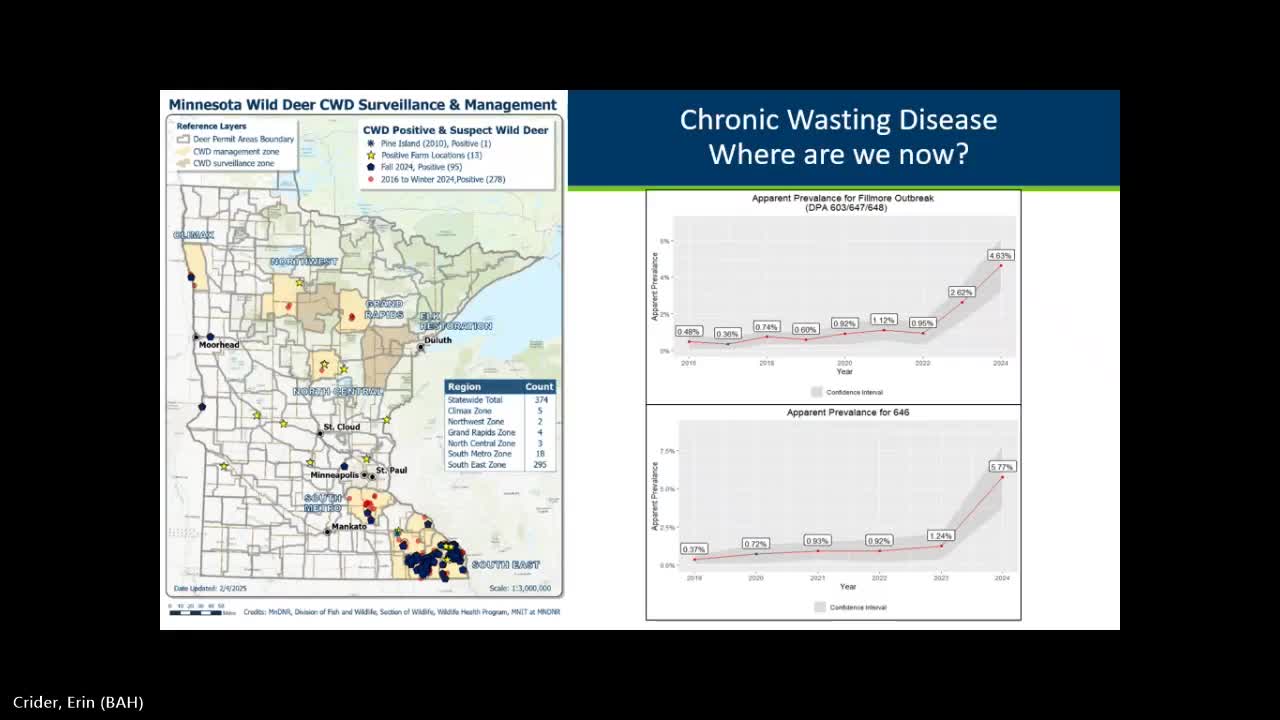Minnesota Board Reports Rise in Chronic Wasting Disease and New Management Areas
September 11, 2025 | Board of Animal Health, Agencies, Boards, & Commissions, Executive, Minnesota
This article was created by AI summarizing key points discussed. AI makes mistakes, so for full details and context, please refer to the video of the full meeting. Please report any errors so we can fix them. Report an error »

Chronic Wasting Disease (CWD) is on the rise in Minnesota, prompting urgent discussions at the Minnesota Board of Animal Health's quarterly meeting on September 11, 2025. Officials reported a concerning increase in CWD cases, particularly in Southeast Minnesota, where prevalence has surged above 5 percent in some areas. This spike has led to the identification of three new infected deer permit areas this past year.
The board highlighted the need for a robust response plan to manage the disease, which is spreading across the state. They outlined three categories of response: initial response for areas with less than 1 percent prevalence, persistent infection for areas between 1 and 5 percent, and endemic CWD for regions exceeding 5 percent prevalence. The situation in Southeast Minnesota has reached the endemic stage, necessitating a reevaluation of management strategies to ensure sustainable surveillance and control efforts.
As part of the 2025 surveillance plan, the board announced the establishment of three new management areas, with mandatory testing for hunters in these zones. The upcoming hunting season will see a significant effort, requiring around 300 staff members to operate 53 check stations and 37 sampling sites. Additionally, the board is implementing feeding and attractant bans in certain areas to reduce deer congregation and limit disease transmission.
The board's discussions underscore the critical need for ongoing monitoring and management of CWD as it continues to expand its footprint in Minnesota. With the disease posing a long-term challenge, officials are committed to developing effective strategies to protect the state's deer population and public health.
The board highlighted the need for a robust response plan to manage the disease, which is spreading across the state. They outlined three categories of response: initial response for areas with less than 1 percent prevalence, persistent infection for areas between 1 and 5 percent, and endemic CWD for regions exceeding 5 percent prevalence. The situation in Southeast Minnesota has reached the endemic stage, necessitating a reevaluation of management strategies to ensure sustainable surveillance and control efforts.
As part of the 2025 surveillance plan, the board announced the establishment of three new management areas, with mandatory testing for hunters in these zones. The upcoming hunting season will see a significant effort, requiring around 300 staff members to operate 53 check stations and 37 sampling sites. Additionally, the board is implementing feeding and attractant bans in certain areas to reduce deer congregation and limit disease transmission.
The board's discussions underscore the critical need for ongoing monitoring and management of CWD as it continues to expand its footprint in Minnesota. With the disease posing a long-term challenge, officials are committed to developing effective strategies to protect the state's deer population and public health.
View full meeting
This article is based on a recent meeting—watch the full video and explore the complete transcript for deeper insights into the discussion.
View full meeting
